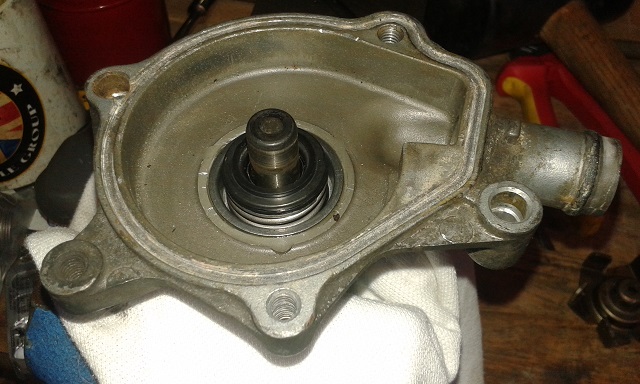
Deauville Water Pump - is the mechanical seal replaceable?
The Deauville's water pump, located in front of and just below the rider's left toe on the lowest part of the engine - follow the chrome pipe backwards - has to keep engine oil on one side of it separate from coolant on the other side. This is achieved by the use of a 'mechanical seal' which is almost, if not completely, identical to the one found on the CX500 family of V-Twin motorcycles dating from between 1978 and 1985. As a longstanding CX owner I've replaced many of these seals, so am particularly familiar with it.
Here are details of the mechanical seals for the CX family of motorcycles.
The mechanical seal consists of two parts, a metal cup containing a spring loaded black ceramic ring-shaped seal which fits into the water pump body; and a white ceramic seal in a rubber cup which locates in the rear face of the water pump impeller, and which rotates with it as the engine turns. The two ceramic faces form, literally, a mechanical seal. That is why coolant used in such engines should ideally be the non-silicate type, this does not contain the tiny silicate fragments which scour the water passages, removing any hard deposits which may form. On an engine with a mechanical seal, the silicates accelerate wear between the two ceramic faces, reducing the seal's life and making it fail earlier than it would otherwise.
The spring-loaded seal is an interference fit in the Deauville's pump body. This means that it is held in place not by a bolt, screw of fastener, but simply by heating the pump body to a high temperature to expand the metal and then driving the seal body in. As the metal subsequently cools, the seal is tightly trapped in the correct location.
As soon as this seal is compromised, or the ceramic faces simply wear past their useful life, coolant seeps out and drains through a hole in the underside of the water pump. Unscrupulous CX owners, unwilling to fix the problem (drop the engine, remove the rear casing, clean, heat it and replace the seal) block this hole and quickly sell the bike, and I suspect that as the Deauville bikes age, the same will happen. So before you buy an old Deau, have a good look under the water pump body to see if this drainhole has been blocked up to conceal a mech seal failure.
Honda claim that the pump is a sealed unit and if the mechanical seal fails, you have no option but to replace the entire pump assembly, at considerable cost. But we don't all have the financial resources to do this and I wanted to see if a repair was practicable. Having been kindly given a very dead Deauville water pump, I dismantled it.

Above the yellow ruler (showing inches) is a new unused CX500 mechanical seal. The left hand part is the spring loaded cup with the black ceramic seal uppermost, and the right hand part - rather appropriately, called the Polo Mint by CX owners - next to it. The Polo Mint locates in the rear face of the impeller and the spring loaded part in its cup is the interference fit in the body of the pump.
Below the yellow ruler you see the damaged spring loaded seal and Polo Mint. In the pump body is the metal cup in which the spring loaded mechanism locates. I haven't removed the cup, but the yellow arrow points to its circumference. So - the $64,000 question - if you seal fails, can you change it? The answer is - YES - as per the details below. But you need two different mechanical seals to make this work.
|
THERE IS GOOD NEWS FOR DEAUVILLE OWNERS! In April 2016 one brave owner has dismantled the water pump from his 650 Deauville, and experimented with fitting the mechanical seal from the CX type engine. This was not a success due to the fact that the CX seal is about 1½ mm smaller in diameter than the aperture of the Deauville's water pump body. However, he has discovered that the mechanical seal from the Honda Pan European is a perfect fit, as per the photo opposite. |
 |
|
|
The "Polo Mint" from the CX500 seal was also found to be a perfect fit in the Deauville's pump impeller. That is why you need the mechanical seal kit from both the CX500 and the Pan European bikes. The seal itself from the Pan and the Polo Mint from the CX. (The old Polo Mint is shown on here on the right.) After road testing, the seal replacement has proved to have been a success. Many thanks to "Monsigna" (Ade) who sent the photos and the descriptions. First class piece of experimental work which I am sure will be a great benefit to Deauville owners in the future. He has made a Youtube video of it. |
Comments etc welcomed, please remove the extra 'z' from the email address and put 'Deauville' or 'zooble' in the message subject or body, so it passes my spam filters.
Back to the Web Resource.